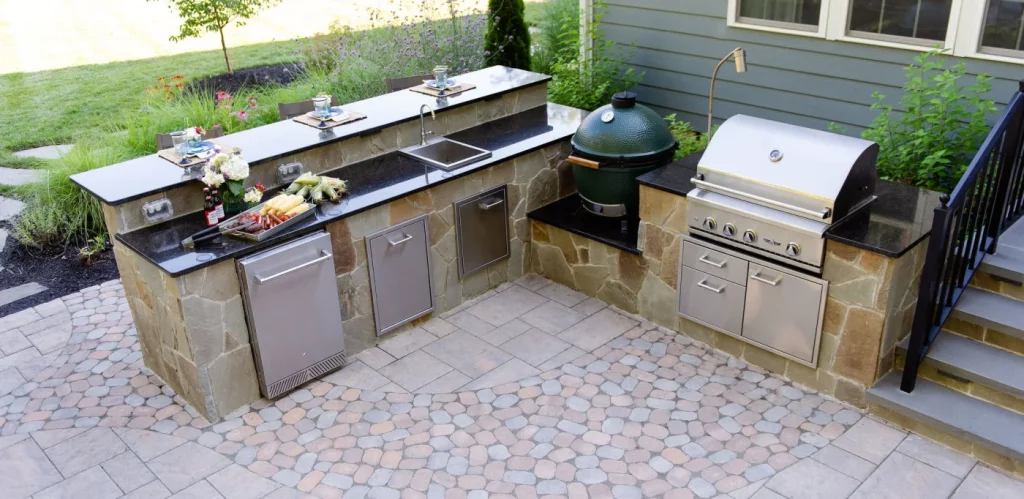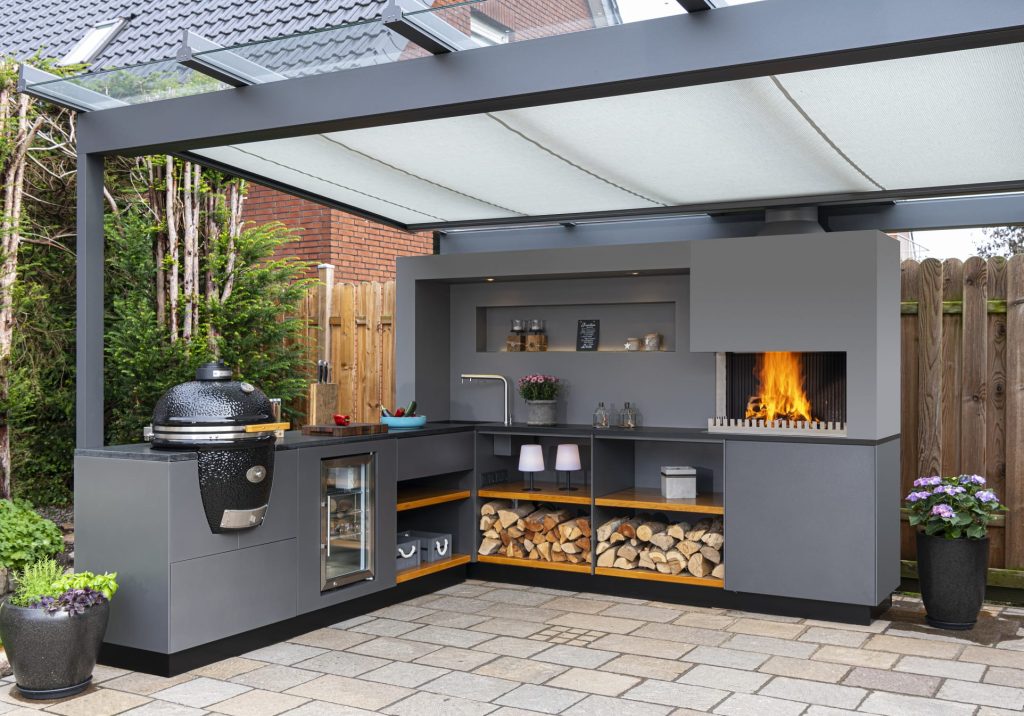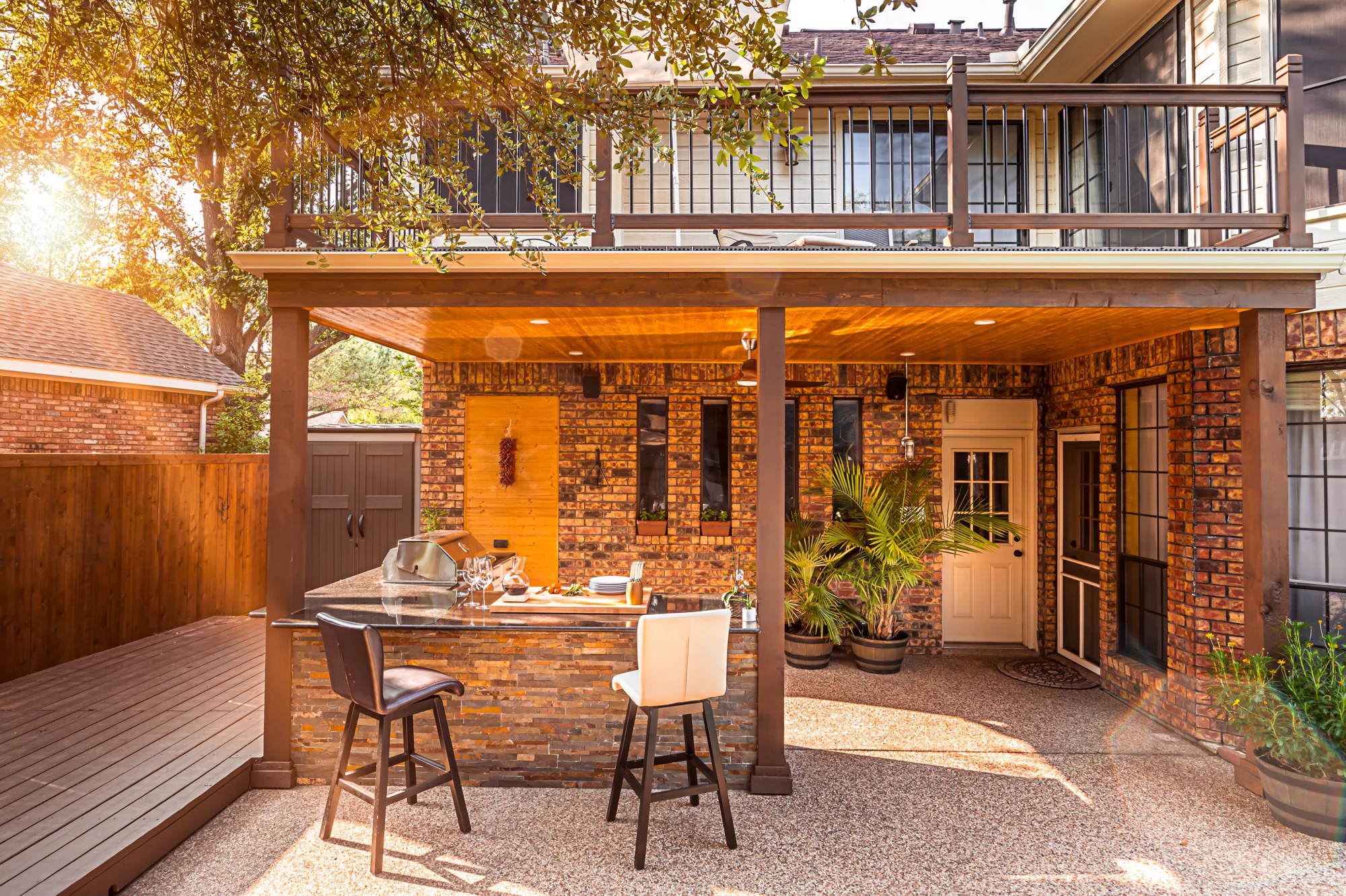An outdoor kitchen transforms your backyard into the ultimate entertaining space while adding significant value to your home. Whether you’re dreaming of weekend barbecues with friends or quiet family dinners under the stars, a well-planned outdoor kitchen extends your living space and creates countless opportunities for memorable gatherings.
The key to a successful outdoor kitchen lies in thoughtful planning that considers your cooking style, entertaining needs, and local climate. From simple grill stations to fully equipped culinary centers, there’s an outdoor kitchen design that fits every budget and lifestyle.
Why Invest in an Outdoor Kitchen?
Outdoor kitchens have become increasingly popular because they offer benefits that go far beyond just cooking outside. They create a natural gathering point for entertaining, keep cooking heat and odors outside during warm weather, and can significantly increase your home’s resale value.
Studies show that outdoor kitchens can return 70-80% of their investment when you sell your home. More importantly, they change how you use your outdoor space, making your backyard feel like a true extension of your indoor living areas.
Essential Planning Considerations
Before diving into design ideas, you’ll need to address several practical considerations that will influence every aspect of your outdoor kitchen project.
Location and Layout: Choose a spot that’s easily accessible from your indoor kitchen but positioned to take advantage of prevailing breezes and views. Consider the sun’s path throughout the day and plan shade accordingly. You’ll also want to think about proximity to utilities like gas, water, and electricity.
Climate Factors: Your local weather patterns will influence material choices, storage solutions, and whether you need overhead protection. Areas with harsh winters may require weatherproof storage or removable components.
Utility Access: Running gas lines, electrical connections, and plumbing to your outdoor kitchen location can be one of the most expensive parts of the project. Plan these connections early and consider hiring professionals for safety and code compliance.
Layout Styles That Work
The layout of your outdoor kitchen should reflect how you cook and entertain. Here are the most popular and functional arrangements.
Linear Layout: Perfect for narrow spaces or against existing structures like your house or a fence. This straightforward design places all appliances and prep areas in a single line, making it efficient for cooking while maintaining conversation with guests.
L-Shaped Configuration: Offers more counter space and storage while creating a natural separation between cooking and socializing areas. This layout works well for corner locations and provides flexibility for different activities.
U-Shaped Design: The ultimate in outdoor kitchen functionality, providing maximum counter space and storage. This layout creates a dedicated cooking zone while allowing multiple people to help with food preparation.
Island Style: A freestanding island creates a 360-degree cooking and entertaining experience. This dramatic option works best in larger spaces and creates multiple zones for different activities.
Galley Setup: Two parallel counters create an efficient workspace similar to many indoor kitchens. This design maximizes functionality in longer, narrower spaces.

Appliance Selection Guide
Choosing the right appliances is crucial for creating an outdoor kitchen that meets your cooking needs and withstands the elements.
Grills and Cooktops: Your primary cooking appliance sets the tone for the entire kitchen. Built-in gas grills offer consistency and convenience, while wood-fired options provide authentic flavor. Consider size based on your typical entertaining numbers, and look for models with good wind resistance and weather protection.
Refrigeration Options: Outdoor refrigerators and ice makers keep beverages cold and ingredients fresh. Choose models specifically designed for outdoor use, with proper insulation and weatherproof construction. Under-counter units save space while full-size refrigerators provide more storage for large gatherings.
Sinks and Prep Areas: Running water makes food prep and cleanup much easier. Install a sink with hot and cold water if possible, and include adequate counter space on both sides for efficient workflow.
Pizza Ovens and Specialty Cooking: Wood-fired pizza ovens create a dramatic focal point and offer unique cooking capabilities. Other specialty options include smokers, tandoor ovens, or built-in woks for diverse cooking styles.
Storage Solutions: Weather-resistant cabinets protect equipment, dishes, and cooking supplies. Choose marine-grade materials or specially treated woods that can handle moisture and temperature changes.
Material Choices for Durability
Outdoor kitchens face challenges that indoor spaces never encounter, so material selection is critical for long-term success.
Countertop Materials: Natural stone like granite or quartzite offers beauty and durability, while engineered quartz provides consistent appearance and lower maintenance. Concrete counters can be customized with colors and textures, and stainless steel provides a professional look that’s easy to clean.
Cabinet Construction: Marine-grade polymer cabinets resist moisture and insects while maintaining their appearance. Stainless steel cabinets offer durability but can show fingerprints and scratches. If you prefer wood, choose naturally weather-resistant species like teak or cedar with proper sealing.
Flooring Options: Stamped concrete, natural stone, and porcelain tiles all work well for outdoor kitchen floors. Choose materials with slip-resistant surfaces and good drainage characteristics.
Structural Elements: For pergolas and overhead structures, consider aluminum, steel, or naturally rot-resistant woods. These elements provide shade and can support lighting, fans, or heaters.
Design Ideas by Budget
Outdoor kitchens can range from simple weekend projects to elaborate installations rivaling indoor spaces. Here’s how to approach different budget levels.
Budget-Friendly Options ($3,000-$8,000): Start with a quality portable grill station, add a prep table with storage, and include a small refrigerator or ice chest. Use existing patio space and add weather-resistant storage cabinets. Simple additions like a pergola or umbrella can provide shade without major construction.
Mid-Range Designs ($8,000-$20,000): Built-in grills with side burners, dedicated sink and prep areas, under-counter refrigeration, and custom storage solutions. Add permanent overhead structures and consider adding a bar area for casual dining.
High-End Installations ($20,000+): Full appliance packages including pizza ovens, multiple cooking surfaces, extensive storage, and premium materials throughout. Include features like outdoor dishwashers, wine storage, and sophisticated lighting and sound systems.
Lighting and Electrical Planning
Proper lighting extends the usability of your outdoor kitchen into evening hours and creates ambiance for entertaining.
Task Lighting: Install adequate lighting over cooking surfaces, prep areas, and cleanup zones. LED under-cabinet lights provide excellent task lighting while consuming minimal energy.
Ambient Lighting: String lights, lanterns, or pendant fixtures create a welcoming atmosphere for dining and socializing. Consider dimmable options for different moods and occasions.
Safety Lighting: Ensure all pathways, steps, and potential hazards are well-lit for safe navigation after dark.
Electrical Requirements: Plan for adequate outlets for appliances, charging stations, and seasonal decorations. All electrical work should be done by licensed professionals using GFCI protection and weather-resistant components.
Weather Protection Strategies
Protecting your investment from the elements ensures years of enjoyment from your outdoor kitchen.
Overhead Coverage: Pergolas, pavilions, or roof extensions protect against sun and rain while maintaining the outdoor feel. Retractable awnings offer flexibility for different weather conditions.
Wind Barriers: Strategic placement of screens, walls, or landscaping can reduce wind impact on cooking flames and create more comfortable conditions for guests.
Seasonal Storage: Plan for storing cushions, small appliances, and other weather-sensitive items during harsh weather or off-seasons.
Drainage Considerations: Ensure proper drainage around your outdoor kitchen to prevent water damage and standing water issues.
Incorporating Dining and Seating
The dining area is where your outdoor kitchen truly shines as an entertaining space.
Counter Seating: Bar-height counters with comfortable stools create casual dining and keep guests close to the cooking action. Plan for 24 inches of counter space per person.
Dining Tables: Separate dining tables provide more formal eating spaces and can accommodate larger groups. Choose weather-resistant materials and consider storage for off-season protection.
Lounge Areas: Comfortable seating areas near but separate from the cooking zone create spaces for relaxation and conversation. Fire pits or outdoor heaters can extend the season in cooler climates.
Shade Solutions: Umbrellas, sail shades, or permanent structures ensure comfortable dining during hot weather.

Landscaping Integration
Your outdoor kitchen should feel like a natural part of your landscape rather than an afterthought.
Plant Selection: Choose plants that complement your cooking activities rather than compete with them. Avoid messy trees over dining areas, but consider aromatic herbs that can enhance your cooking.
Privacy Screening: Strategic landscaping can create intimacy and block unwanted views while maintaining airflow around cooking areas.
Hardscape Connections: Extend paving materials and design elements from your outdoor kitchen to create visual connections with other landscape features.
Water Features: The sound of running water can mask neighborhood noise and create a more serene dining environment.
Maintenance and Care
Proper maintenance protects your investment and ensures years of reliable service.
Regular Cleaning: Develop routines for cleaning appliances, counters, and storage areas. Use appropriate cleaners for different materials to avoid damage.
Seasonal Preparations: Winterize gas lines and water connections in cold climates. Cover or store removable components to protect them from harsh weather.
Preventive Maintenance: Schedule regular maintenance for gas appliances, clean ventilation systems, and inspect weather-resistant seals and finishes.
Deep Cleaning: Plan for thorough cleaning and inspection at least twice per year to identify and address potential problems early.
Getting Started with Your Project
Begin by assessing your current outdoor space and envisioning how you want to use your new kitchen. Create a wish list of features, then prioritize based on your budget and needs.
Consider starting with a basic setup that can be expanded over time. This approach spreads costs and allows you to learn what features you actually use most often.
Get multiple quotes from contractors and check references carefully. Outdoor kitchen construction involves multiple trades including electrical, plumbing, and gas work that require proper permits and professional expertise.
Making the Most of Your Investment
An outdoor kitchen is more than just appliances and counters – it’s about creating experiences and memories. Think about how you entertain now and how you’d like to entertain in the future.
Consider the view from your indoor kitchen and living spaces. Your outdoor kitchen should enhance these views rather than block them.
Plan for growth in your entertaining style. If you love hosting large gatherings, ensure your design can accommodate those needs even if you’re starting with a smaller setup.
The best outdoor kitchens reflect their owners’ personalities and cooking styles while working harmoniously with the home’s architecture and landscape. Take time to plan carefully, choose quality materials, and create a space that will provide years of enjoyment for family and friends.
Your outdoor kitchen represents an investment in your lifestyle and your home’s value. With thoughtful planning and quality construction, it will become the heart of your outdoor living space and a source of countless memorable gatherings.
